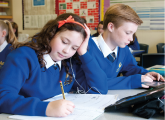How aware are your students of the potential impact of their online activity? Ollie Bray has some suggestions to help them improve their understanding…
How aware are your students of the potential impact of their online activity? Ollie Bray has some suggestions to help them improve their understanding…
TODAY YOU WILL…
- GAIN AN UNDERSTANDING OF WHAT WE MEAN BY ‘DIGITAL FOOTPRINTS’
- THINK CRITICALLY ABOUT WHAT YOU SHOULD AND SHOULD NOT WRITE ON YOUR SOCIAL NETWORKING SPACE AND HOW IT MAY BE VIEWED BY OTHERS
- IMPROVE YOUR UNDERSTANDING OF WHAT WE MEAN BY ‘PRIVACY’ AND HOW YOUR PRIVACY MAY BE IMPACTED THROUGH YOUR USE OF THE WEB
Inside the school gates do you still get get twitchy about Twitter and fed up with Facebook? Whether you love or hate these and other social media services, the one thing that everyone seems to agree on is that they are here to stay for at least the short term. They have become such a popular feature of modern culture; from # (hash) tags at the Olympic games to signs in shop doors asking you to ‘like’ them on Facebook – social media just seems to be everywhere.
I’m not going to lecture here on either the benefits or risks of social media in schools (and there are lots of both), but rather, I would like to equip you with a few ideas to help you encourage young people to think about using social media responsibly. It is a lesson that is equally suited to an ICT, citizenship or PSHE class – and contains ideas that all secondary teachers should have in their digital literacy and safeguarding toolbox.
STARTER ACTIVITY
Begin the lesson by showing students a picture of a footprint in the sand, and explain that you are going to start the lesson today by talking about feet. In particular, digital feet and digital footprints. Challenge your class to tell you what a ‘digital footprint’ is. According to Wikipedia a digital footprint is:
“…the data trail left by interactions in a digital environment; including the use of TV, mobile phone, the World Wide Web, the internet and other connected devices and sensors. Digital Footprints provide data on what has been performed in the digital environment (e.g. what you clicked on, searched for, Liked, where you went, your l ocation, your IP address, what you said, what was said about you); and the data can be used in behavioural targeting, behavioral economics, personalisation, targeted marketing, digital reputation, social influence and other social media or social graphing services. In social media, a digital footprint can refer to the size of a person’s ‘online presence’ measured by the number of individuals with whom they interact.” The use of the above Wikipedia definition is important, as it can lead to a discussion about the reliability of such digital sources. Use it as a context for discussion. Do your students understand and can they explain the key concepts? Would they change the article in any way (remember they could actually do this as anyone can edit Wikipedia!)? Finally, ask your class when they think young people in Europe gain a digital footprint. You will get a variety of responses to this and there is not really any robust evidence. However, this 2010 research from AVG (http://goo.gl/4klvM) provides a useful context for debate.
MAIN ACTIVITIES
THE WAYBACK MACHINE
It is almost impossible to delete anything from the Internet. In fact one of the only ways to be really sure that your information has been removed is to know exactly where it is stored (in a data centre somewhere?) and to physically destroy the server. It’s important for young people to understand that bits of the Internet are actually being copied all of the time (it’s one of the reasons that Google Search is so fast), and a nice way to demonstrate this in a playful way is to get students to experiment with the Wayback Machine (archive.org/web/web.php), which has copied and catalogued over 300 billion web pages – it works a bit like a national library. When you type a website’s URL into the Wayback Machine you can see the times that it has been copied and click on these key dates to ‘take you back’ and see what the site was like at the time. A good, safe example to use with young people is the UK Parliament Website (parliament.uk), which has archive going all the way back to 1996.
One of the challenges that is often faced in schools is how to teach young people to behave in a responsible way using social media if some of the key sites (such as Facebook) are blocked to both pupils and staff. A useful activity is to get young people to build dummy profiles and use these as a context for learning. For example, you can use Fakebook (tinyurl.com/tsict to build a ‘Facebook-esque’ profile, with a picture and a comment wall. There are lots of ways that this resource can be used. Ask a pupil to create a profile that purposefully gives away personal information. Other members of the class could then provide feedback to suggest how the sharing of this information could be improved. Or you could get learners to make up profiles for historical characters, such as Guy Fawkes, leading up to the Gunpowder Plot. Could the kind of information he gives away through social media lead to him being captured?
PRIVACY
Privacy tends to be one of those words that most people say they are concerned about but not many can accurately define. But definitions are very important when teaching digital literacy skills. It is important that both teachers and students all speak a common language to avoid mixed messages and confusion. Get every member of the class to write a definition of ‘privacy’ on a sticky note, which can then be arranged on a wall and discussed. You might be surprised at the varied responses that you get from a single class.
Perceptions about privacy also change as young people progress up through the school. Sometimes it is just useful to present students with the facts. This article, (tinyurl.com/tsict2), from the BBC Technology Blog in March 2013, is great to get young people thinking deeply about how much information they casually give away about themselves. The article explains that research carried out by Cambridge University using over 58, 000 volunteers was able to predict with a great deal of accuracy the religion, political views, race and sexual orientation of people despite their privacy settings – simply by analysing ‘likes’ on Facebook. The article provides a number of opportunities for ‘big’ questions around the lack of transparency about how users’ data is being used, in particular for commercial gains.
KEY RESOURCE
HUE ANIMATION STUDIO gives you everything you need to make stop motion movies. Simply install the easy to use software, connect the HUE camera and within minutes you’re ready to start animating, using anything from cut-outs, drawings, and modelling clay to everyday classroom items. Imagine - think of a story, the characters and what happens to them Create - build your set and props and make your characters Learn - develop your skills as a movie maker and learn about new subjects by using animation to bring them to life. Used by schools as a teaching tool, HUE Animation is a great way to encourage children to work together and promote creative learning across all disciplines. Go to hueanimation.com/schools for a free 30 days trial.
SUMMARY
Rather than a traditional question and answer summary activity, consider the phrase “The Solution is in the Problem”, which comes from the computer games designer Cliff Dennett. The theory goes that if the internet is the problem then it is also the solution.
So, as a summary activity for the lesson ideas described above, try to get your class to come up with an idea to provide safe and responsible use advice though the internet itself, incorporating the key messages from your lesson. For example, students could quickly design a targeted advert for Facebook or record a 60-second viral YouTube Clip on their mobile phone. Limit this activity to five minutes to create a sense of purpose and urgency.
HOMEWORK
This activity lends itself to encouraging students to go home and carry out an audit of their social networking profile and online behaviour. They should be encouraged to think about and change privacy settings.
One way to frame this task with older students is to set it in the context of helping a younger child (eg: a brother or sister). There is growing evidence to suggest that peer support through the model behaviour of an older child is a good way to improve behaviour and responsible use between groups of children.
INFO BAR
USEFUL LINKS CEOP (CEOP.POLICE.UK ) – THE CHILD EXPLOITATION AND ONLINE PROTECTION CENTRE THINK U KNOW (THINKUKNOW.CO.UK) – THE EDUCATIONAL INITIATIVE OF CEOP. IT HAS THE DEDICATED REPORTING FACILITY OR ‘CEOP BUTTON’ THAT HAS BECOME WELL ESTABLISHED IN THE UK. INTERNET WATCH FOUNDATION (IWF.ORG.UK) – THE LEADERS IN COMBATING ILLEGAL ONLINE CONTENT, WORKING GLOBALLY WITH INTERNET PROVIDERS TO REMOVE ILLEGAL CONTENT. CHILDNET (CHILDNET.COM) – THE CHILDNET INTERNATIONAL WEBSITE PROVIDES RESOURCES FOR CHILDREN, YOUNG PEOPLE, PARENTS/CARERS AND PROFESSIONALS.
ABOUT THE EXPERT
Ollie Bray (olliebray.com) works internationally with teachers, schools and governments to improve education outcomes for learners through the appropriate use of technology and the outdoors. He has been a senior policy advisor to government, school leader, head of department and is an award winning teacher. He is currently deputy head teacher at Grantown Grammar School.









